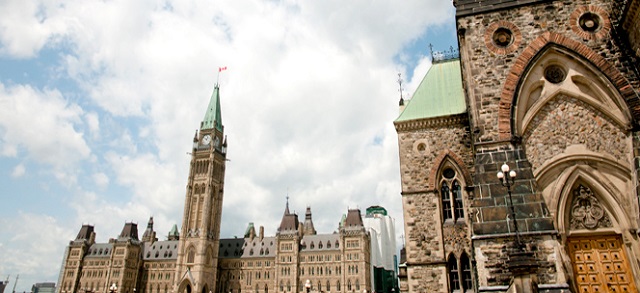Business
33 per cent jump in one year! Nearly 147,000 federal bureaucrats take six-figure salary

There are now 146,786 federal bureaucrats taking a salary of more than $100,000 a year — approximately a 33 per cent jump in just one year, according to access-to-information records obtained by the Canadian Taxpayers Federation.
“Taxpayers can’t afford to keep bankrolling a bloated government full of overpaid paper pushers,” said Franco Terrazzano, CTF Federal Director. “The government needs to find savings and it should start by taking air out of its ballooning bureaucracy.”
Federal bureaucrats taking six-figure salaries rose sharply between 2023 and 2024, continuing an ongoing trend of increasingly highly paid bureaucrats since 2015.
A total of 146,786 federal employees received more than $100,000 annually in 2024, which is up from 110,593 the previous year.
For comparison, Statistics Canada data shows the average Canadian full-time worker earned just over $70,000 in 2024.
The federal government employed 374,465 bureaucrats as of Dec. 31, 2024, according to the records. That means that 39 per cent of the federal bureaucracy took a six-figure salary last year.
The six-figure salaries cost taxpayers $18.9 billion in 2024. However, that figure is likely understated because retroactive pay raises for 2024 “have yet to be negotiated or adjusted in the pay files,” according to the records. Further, the records obtained by the CTF only detail base salary and do not include the cost of other benefits paid out to bureaucrats.
In the last decade, the number of federal bureaucrats taking six-figure salaries more than tripled. In 2015, 43,424 employees cleared the $100,000 mark; by 2024, that figure climbed to 146,786 — a 238 per cent spike.
The CTF has called on the federal government to implement an annual “sunshine list” to proactively disclose the number of employees taking a six-figure salary.
Every provincial government, except Prince Edward Island and Quebec, provides its taxpayers with an annual compensation disclosure list.
“A sunshine list is government transparency 101,” Terrazzano said. “The government must be transparent with taxpayers and that means publishing a sunshine list to disclose salaries for highly paid bureaucrats.
“Taxpayers pay the bills so taxpayers deserve to know how many six-figure bureaucrats we’re paying for.”
The total size and cost of the federal bureaucracy has also ballooned over the decade.
The federal government added about 99,000 employees since 2016.
The federal bureaucracy cost taxpayers $40.2 billion in 2016, according to the Parliamentary Budget Officer. The bureaucracy cost taxpayers $71.2 billion last year. That means the cost of the federal bureaucracy increased 77 per cent since 2016.
The spike in the bureaucracy costs occurred during years of underwhelming performance results across federal departments and agencies.
“I have noticed a marked increase in the number of public servants since 2016 and a proportional increase in spending,” Parliamentary Budget Officer Yves Giroux said. “But we haven’t seen similar improvements when it comes to service.”
The PBO also found that “less than 50 per cent of [performance] targets are consistently met within the same year.”
Half of Canadians say federal services have gotten worse since 2016, according to a Leger poll commissioned by the CTF. That’s despite the cost of the federal bureaucracy growing 77 per cent. The poll also found that 54 per cent of Canadians want the government to cut the size and cost of the federal bureaucracy.
“Taxpayers are paying for way more highly paid bureaucrats, but Canadians still aren’t getting better services,” Terrazzano said. “Prime Minister Mark Carney should listen to Canadians and cut the size and cost of government bureaucracy.”
Business
The Grocery Greed Myth

Haultain’s Substack is a reader-supported publication.
To receive new posts and support our work, please consider becoming a free or paid subscriber.
Try it out.
The Justin Trudeau and Jagmeet Singh charges of “greedflation” collapses under scrutiny.
“It’s not okay that our biggest grocery stores are making record profits while Canadians are struggling to put food on the table.” —PM Justin Trudeau, September 13, 2023.
A couple of days after the above statement, the then-prime minister and his government continued a campaign to blame rising food prices on grocery retailers.
The line Justin Trudeau delivered in September 2023, triggered a week of political theatre. It also handed his innovation minister, François-Philippe Champagne, a ready-made role: defender of the common shopper against supposed corporate greed. The grocery price problem would be fixed by Thanksgiving that year. That was two years ago. Remember the promise?
But as Ian Madsen of the Frontier Centre for Public Policy has shown, the numbers tell a different story. Canada’s major grocers have not been posting “record profits.” They have been inching forward in a highly competitive, capital-intensive sector. Madsen’s analysis of industry profit margins shows this clearly.
Take Loblaw. Its EBITDA margin (earnings before interest, taxes, depreciation, and amortization) averaged 11.2 per cent over the three years ending 2024. That is up slightly from 10 per cent pre-COVID. Empire grew from 3.9 to 7.6 per cent. Metro went from 7.6 to 9.6. These are steady trends, not windfalls. As Madsen rightly points out, margins like these often reflect consolidation, automation, and long-term investment.
Meanwhile, inflation tells its own story. From March 2020 to March 2024, Canada’s money supply rose by 36 per cent. Consumer prices climbed about 20 per cent in the same window. That disparity suggests grocers helped absorb inflationary pressure rather than drive it. The Justin Trudeau and Jagmeet Singh charges of “greedflation” collapses under scrutiny.
Yet Ottawa pressed ahead with its chosen solution: the Grocery Code of Conduct. It was crafted in the wake of pandemic disruptions and billed as a tool for fairness. In practice, it is a voluntary framework with no enforcement and no teeth. The dispute resolution process will not function until 2026. Key terms remain undefined. Suppliers are told they can expect “reasonable substantiation” for sudden changes in demand. They are not told what that means. But food inflation remains.
This ambiguity helps no one. Large suppliers will continue to settle matters privately. Small ones, facing the threat of lost shelf space, may feel forced to absorb losses quietly. As Madsen observes, the Code is unlikely to change much for those it claims to protect.
What it does serve is a narrative. It lets the government appear responsive while avoiding accountability. It shifts attention away from the structural causes of price increases: central bank expansion, regulatory overload, and federal spending. Instead of owning the crisis, the state points to a scapegoat.
This method is not new. The Trudeau government, of which Carney’s is a continuation, has always shown a tendency to favour symbolism over substance. Its approach to identity politics follows the same pattern. Policies are announced with fanfare, dissent is painted as bigotry, and inconvenient facts are set aside.
The Grocery Code fits this model. It is not a policy grounded in need or economic logic. It is a ritual. It gives the illusion of action. It casts grocers as villains. It gives the impression to the uncaring public that the government is “providing solutions,” and that “it has their backs.” It flatters the state.
Madsen’s work cuts through that illusion. It reminds us that grocery margins are modest, inflation was monetary, and the public is being sold a story.
Canadians deserve better than fables, but they keep voting for the same folks. They don’t think to think that they deserve a government that governs within its limits; a government that accept its role in the crises it helped cause, and restores the conditions for genuine economic freedom. The Grocery Code is not a step in that direction. It was always a distraction, wrapped in a moral pose.
And like most moral poses in Ottawa, it leaves the facts behind.
Haultain’s Substack is a reader-supported publication.
To receive new posts and support our work, please consider becoming a free or paid subscriber.
Try it out.
Business
Tax filing announcement shows consultation was a sham

The Canadian Taxpayers Federation is criticizing Prime Minister Mark Carney for announcing that the government is expanding automatic tax filing within hours of the government’s consultation ending.
“There’s no way government bureaucrats pulled an all-nighter reading through thousands of submissions and survey responses before sending Carney out to make an announcement on automatic tax filing the next morning,” said Franco Terrazzano, CTF Federal Director. “Asking Canadians for their opinion and then ignoring them isn’t a good look for Carney, it makes it look like the government is holding sham consultations.”
The government of Canada announced consultations on automatic tax filing so Canadians could give the government “broad input through an online questionnaire.”
The government’s consultation ended on Thursday, Oct. 9, 2025.
Hours after the consultation ended, Carney today announced the government would expand automatic tax filing.
The CRA is already one of the largest arms of the federal government with 52,499 bureaucrats.
The CRA added 13,015 employees since 2016 – a 33 per cent increase. For comparison, America’s Internal Revenue Service has 90,516 bureaucrats. The CRA has one bureaucrat for every 800 Canadians. The IRS has one bureaucrat for every 3,800 Americans.
“The CRA can barely answer the phone, so Carney shouldn’t be giving those bureaucrats more busy work to do,” Terrazzano said. “The CRA is a bloated mess, and Carney should be cutting the cost of bureaucracy not scheming up ways to give the bureaucracy more power over taxpayers.”
The CRA only answered about 36 per cent of the 53.5 million calls it received between March 2016 and March 2017, according to a 2017 Auditor General report. When Canadians were able to get the CRA on the phone, call centre agents gave inaccurate information about 30 per cent of the time.
“The CRA acting as both tax collector and tax filer is a serious conflict of interest,” Terrazzano said. “Trusting the taxman to do your tax return is like trusting your dog to protect your burger.
“Carney should stop the CRA power grab and instead cut taxes and simplify the tax code.”
-

 National21 hours ago
National21 hours agoCanada’s birth rate plummets to an all-time low
-

 Crime20 hours ago
Crime20 hours agoPierre Poilievre says Christians may be ‘number one’ target of hate violence in Canada
-

 Alberta19 hours ago
Alberta19 hours agoJason Kenney’s Separatist Panic Misses the Point
-

 Automotive22 hours ago
Automotive22 hours agoBig Auto Wants Your Data. Trump and Congress Aren’t Having It.
-

 Alberta2 days ago
Alberta2 days agoFact, fiction, and the pipeline that’s paying Canada’s rent
-

 Alberta2 days ago
Alberta2 days agoAlberta Is Where Canadians Go When They Want To Build A Better Life
-

 COVID-191 day ago
COVID-191 day agoTamara Lich says she has no ‘remorse,’ no reason to apologize for leading Freedom Convoy
-

 Business18 hours ago
Business18 hours agoCarney government plans to muddy the fiscal waters in upcoming budget








